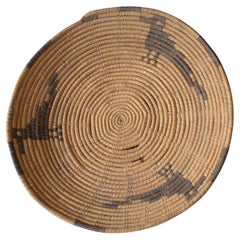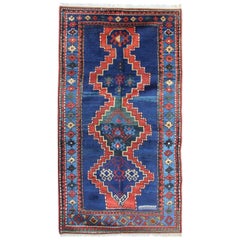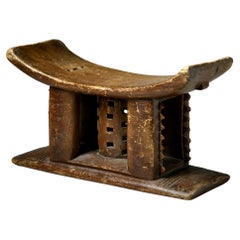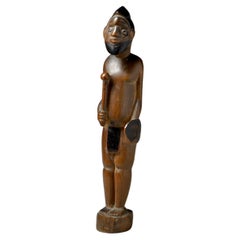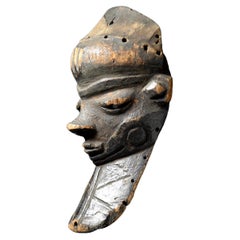Tribal Art
2
563
to
53
291
192
563
563
563
24
3
1
1
1
50
180
990
34
383
385
68
8
1
15
21
20
31
27
15
13
5
320
136
70
51
36
307
263
185
95
75
9
8
6
3
2
Tribal Art For Sale
Period: 19th Century
Period: Early 20th Century
Native American Antique Pima Basket with eagle motive
Located in London, GB
Native American Antique Pima Basket with bird or eagle motive
Vintage Pima early 20th century
Willow and Devils Claw Basket or Tray,
Width 9 inches...
Category
Early 20th Century American Tribal Art
Materials
Willow
Antique Rugs Blue Caucasian Kazak Rugs, Geometric Carpet Livingroom Rug
Located in Hampshire, GB
Kazak rugs have primarily been produced as village productions rather than city pieces. Made from materials particular to individual tribal provinces and the rugs of the Caucasus typically display bold geometric designs in primary colours. Kazak rugs are a type of Armenian rug...
Category
Late 19th Century Caucasian Kazak Antique Tribal Art
Materials
Natural Fiber, Organic Material, Wool
Asante stool
Located in London, GB
Asante (Ashanti) stool
mmaa gwa
Ghana
Wood
20cm x 33cm
Category
Early 20th Century African Tribal Art
Materials
Wood
19th Century Iron African Currency Blade
Located in Vancouver, BC
Wonderful object with arrow shaped blades. Beautiful decorative with complex and fascinating history;
Iron currency tokens are among the most compelling and virtuosic of sub-Sahara...
Category
Late 19th Century African Antique Tribal Art
Materials
Iron
Tsonga figure
Located in London, GB
Tsonga figure
South Africa
Wood
21cm
Category
Early 20th Century Tribal Art
Materials
Wood
Pende mask
Located in London, GB
Kiwoyo-Muyombo mask
Pende
DRC
Wood
30cm
small restoration on the top
on a professional customised metal stand
ex private collection London, UK
Category
Early 20th Century African Tribal Art
Materials
Wood
African Currency, 19th Century
Located in Dallas, TX
This set of 3 pieces of African currency is very interesting. Looking like some sort of ancient maraca, these 19th century pieces jingle and noise-make with each step. The dimensions...
Category
19th Century African Antique Tribal Art
Materials
Metal
Figurative Guro heddle pulley
Located in London, GB
Guro pulley
Ivory Coast
Wood
26cm
on a customised metal stand
Category
Early 20th Century African Tribal Art
Materials
Wood
Lwena staff
Located in London, GB
Lwena staff
Angola
Wood
43cm
Provenance:
- Michel Koenig, Brussels, 1970s
Category
Early 20th Century African Tribal Art
Materials
Wood
Zabihi Collection Antique Tabriz Willow Tree Rug
Located in New York, NY
1920s Persian Tabriz Rug with a weeping willow tree design on a slightly worn dark field
Details
rug no. j3181
size 10' 1" x 14' 6" (307 x 442 cm)
Category
Early 20th Century Persian Bakshaish Tribal Art
Materials
Wool
Antique Ceremonial Ashanti Ghana African Queens Wooden Stool mmaa dwa
Located in London, GB
An antique Ashanti ceremonial stool, carved from a single piece of wood. The up-curved seat stands on five supports, the central one pierced with small semi circles and the outer four supports carved, fretted.
In very good condition
Length 46cm
Height 34cm
Width 24cm
The origin of the Ashante culture can be found in the Akan ethnic groups that inhabited West Africa around Lake Volta and the Gulf of Guinea. The Asante formed a strong confederation that developed from the late 17th century, with the founding of the city of Kumasi, and whose economy was based on trade, gold mining and slave traffic. They are the most important and larger ethnic group in Ghana and was one of the few African states capable of resisting European imperialism.
Within the material heritage and furniture of the Ashante people, some of the most outstanding pieces are the ceremonial stools, being the Golden Stool...
Category
Early 1900s Ghanaian Tribal Antique Tribal Art
Materials
Wood
Early 20th Century Prestige Cloth, Dida People, Ivory Coast
Located in Point Richmond, CA
Early 20th century prestige cloth, Dida people, Ivory Coast
Raffia, natural dyes
An engaging example of resist-dyed prestige cloths, this raffia fragment is professionally mounted o...
Category
Early 20th Century Ivorian Tribal Tribal Art
Materials
Raffia
Early 20th Century Shaman Body Bag
Located in Chicago, IL
Shaman body bags from the early 20th century were sacred and significant artifacts used in certain cultural practices and rituals among various indigenous communities and shamans in ...
Category
Early 20th Century African Tribal Art
Materials
Goat Hair
Aboriginal Fine Antique Wunda Shield Australia Tribal Art Interior Design
Located in London, GB
Fine large Antique Aboriginal Wunda shield in hard wood carved on both sides with a highly artistic Zigzag Geometric fluted design colored with red and and white pigment & paint.
The...
Category
Early 20th Century Australian Tribal Art
Materials
Hardwood
extremely rare Algerian Judaica silver, jewish Dowry box early 19th century
Located in Tel Aviv - Jaffa, IL
Amazing and scarce JUDAICA object, we have here one of the most touching jewish objects we had for a long time, this small silver dowry box was made in Algeria in the early 19th century, it is all covered with symbols of jewish faith and of couples, the sliding lid has 2 flanking birds with hamsa (protective hand) on each side and a flower vase in the middle.
one side shows two flanking lions with a tree in the middle and the other side shows again two big and two small birds with a flower bowl in the middle, front side has a key hole and next to it there is the Hebrew inscription ס״ט״" which says Siman tov or in English "a good sign" it is taken from the wedding blessing, underneath the lock there is another inscription with the name ״עזיזה בת אברהם בן חמו״ which is the name of the bride, her father and her grandfathers name.
the box is full marked a lot of times with the silversmith mark, every side of the box is marked.
this box was probably ordered by the grooms family to hold the jewelry they are giving to the bride as dowry, this type of objects are rare and there are just a few of them on museum collections.
DOWRY (Heb. נְדֻנְיָה), the property a wife brings to her husband at marriage; the Yiddish equivalent, nadn, is from the same root. The custom of nedunyah became clearly defined and institutionalized only in the talmudic period. In biblical times, mohar (מֹהַר), whereby the groom bought his wife from her father (Gen. 24:53; Ex. 22:15–16; Hos. 3:2), was the accepted practice. It was then customary that the groom give the bride gifts, and that she bring certain property to her husband's home upon marriage: slaves, cattle, real estate, etc. (cf. Gen. 24:59–61; 29; Judg. 1:14ff.; I Kings 9:16). Evidence of the custom of nedunyah is to be found in Tobit (7:14; 8:21) and in the Assuan papyri (Cowley, Aramaic, nos. 15, 18). Gradually, mohar was superseded by the ketubbah custom according to which the husband merely assumed the responsibility of compensation to his wife in case he divorced her: he had to pay her 200 zuzim if she had been a virgin at the time of marriage, and 100 zuzim if a widow or divorcée (see *Ketubbah).
By talmudic times, the institution of nedunyah was prevalent; the father gave a dowry to the bride since the daughter was excluded from paternal inheritance. Fifty zuzim (equivalent to the worth of 180 grams of silver) was the minimum amount a father was obliged to give to his daughter (Ket. 6:5). Parents usually gave much more, according to their social standing. Community funds provided the dowry for an orphan or a very poor girl (ibid.; cf. Sh. Ar., YD 251:8). In case of her father's death, the brothers of a minor girl were obliged to give her the minimum dowry, and the court estimated how much her father would have given her above the minimum dowry. The sum was then taken out of the father's estate and given to the daughter upon majority (Ket. 6:6; 68a–69b). In the absence of such an estimate, each daughter was entitled to receive one-tenth of the value of her father's estate in money, or in valuables (Yad, Ishut, 20:4–7; Sh. Ar., EH 113:4). If the father was unable or unwilling to pay the promised dowry at the betrothal ceremony, the groom could refuse to marry his bride (Ket. 13:5; Ket. 108b–109a). Insistence on exact payment of the promised dowry, however, was frowned upon by later rabbinic authorities (Rema to Sh. Ar., EH 2:1). In certain communities it was customary for the groom's father to make a dowry contribution equal to that of the bride's father (Ket. 102b). The dowry, whether given in real estate, slaves, money, or chattel was recorded in the marriage contract (the ketubbah) and in some instances one-third or one-fifth of the actual value of the dowry was added to the sum mentioned in the ketubbah. Based upon a decree enacted by *Simeon b. Shetah (first century C.E.), the Talmud ruled that the husband and his entire property were liable for compensation as stipulated in the ketubbah, either in case he died (when she collected the sum specified in the ketubbah from the heirs) or in case he divorced his wife (Ket. 82b). For the status of the dowry and the husband's rights and obligations, see below. The rabbinic enactments (Takkanot Shum) by R. Jacob *Tam and by the rabbinic synod of the communities of Speyer, Worms, and Mainz (Germany) stipulated that if a woman died...
Category
Mid-19th Century Algerian Antique Tribal Art
Materials
Silver
Early Large Ashanti Polychrome Mother Drum, Ghana early 20th century Osei Bonsu
Located in Point Richmond, CA
This is a "Mother drum", Asante, Ghana. with polychrome paints, Circa 1935. In the style of the well-known carver Osei Bonsu (1900-1977).
Low relief imagery envelopes the body of t...
Category
Early 20th Century Ghanaian Tribal Tribal Art
Materials
Wood
Beautiful Vintage Italian multi strand Seed coral pearl necklace
Located in London, GB
Beautiful Vintage Italian multi strand Seed coral pearl necklace
Real Italian salmon red Coral imitation pearl and black malachite
Italian
Peri...
Category
Early 20th Century Italian Tribal Art
Materials
Coral
Ancient Fiji Islands Flat Serving Bowl or Platter 19th century Polynesia
Located in Point Richmond, CA
Ancient Fiji Islands Flat Serving Bowl or Platter 19th century, made of very dense hardwood with deep patina, and expected wear on bottom. Two small opposing holes for suspension.
B...
Category
Late 19th Century Fijian Tribal Antique Tribal Art
Materials
Wood
Antique Akha Hill Tribe Silver Cuff Bracelet, 517grams
Located in Jimbaran, Bali
An exceptionally large Akha Tribe woven silver bracelet with spiral design. This Tribal bracelet encompasses tradition Hill tribe silversmithing techniques ...
Category
Early 20th Century Thai Tribal Tribal Art
Materials
Silver
Ulo Tribal Akha Woman's Headdress with Framework of Bamboo and Beads
Located in Yonkers, NY
A Ulo Akha woman's Tribal headdress adorned with framework of bamboo, beads, pompons, seeds and other unique items. Immerse yourself in the rich cul...
Category
Early 20th Century Thai Folk Art Tribal Art
Materials
Fabric, Bamboo, Beads
Antique Ethnic Artifact Sepik River Cassowary Bone from Papua New Guinea
Located in North Hollywood, CA
Antique Ethnic Artifact Sepik River Cassowary Bone from Papua New Guinea
For many groups in Papua New Guinea, bone was an important medium for making tools of all types. This artifact is made from leg bone of a cassowary, a large, flightless, and extremely dangerous, bird.
Cassowaries also play an important role in the mythology of groups in the Sepik River area.
Though no longer used these bone artifacts are still used ceremonially. They often play important roles in male initiation and other rituals. They are also worn as personal adornment by tucking them into a band of braided fibers worn around the upper arm.
Antique Ethnic Bone Cassowary Artifact with minimal carving and incised design confined to the joint end.
A small hole has been drilled through from both sides of the top and presumably for the threading of a cord.
The bone has been partially divided near the top and to form two prongs that project down the back of the dagger possibly allowing the user to wear is tuck into a waist band or belt.
Origin Papua New Guinea Maprik Dist Area
From the Art Collection of Marian and John Scott, acquired in 1962.
Similar items are in display in the Timothy S. Y. Lam Museum of Anthropology.
Purchased from the amazing private collection of Mark Lissauer who spent his life collecting niche ethnographic pieces.
About Mark Lissauer:
Mark Lissauer spent forty years travelling abroad for months at a time collecting ethnographic artefacts primarily from New Guinea and the islands of the West Pacific, and from Asia and Himalayan countries. Fluent in five languages and having in the course of business travelled to more than forty countries, Mark is well-known to museums and art-collectors around the world for his long career and his interesting and diverse collection of rare ethnographic material.
Mark knows the origin and symbolism of each piece. Through extensive research and more than ninety trips around the globe, Mark familiarised himself with the traditions of the various cultures he visited in order to understand the meaning of each object to its region and tribe. His home has a specialist library and several rooms are filled with tribal carvings, textiles and ethnographica.
He acquired his first tribal piece in 1948 during a business trip to Milne Bay, New Guinea, and has since documented the acquisition of some 35,000 items. Several thousands of these have been sold to important private collections and museums worldwide, including the Rockefeller Museum, the British Museum and the Musée National des Arts d’Afrique et d’Océanie, now incorporated into the Louvre Museum.
Estimator certificate of authenticity by Wayne Heathcote Tribal Art Dealer and Expert.
Heathcote has a flash gallery in Brussels, where much of the tribal art business is centred, and is an expert at Sotheby's tribal art sale...
Category
Early 20th Century Folk Art Tribal Art
Materials
Bone
Moroccan Berber Wooden Sugar Hammer Marteau a Sucre Deggaga
Located in North Hollywood, CA
Moroccan Berber hand-carved wooden sugar hammer "Deggaga".
Handcrafted by the Berber women of Morocco, hand-carved and hand painted wood with tribal desig...
Category
Early 19th Century Moroccan Islamic Antique Tribal Art
Materials
Wood
Early 20th Century Ceremonial Chiefs Coat From Africa
Located in Chicago, IL
An early 20th-century ceremonial chief's coat from Africa represents a magnificent display of cultural heritage and craftsmanship. These coats hold deep significance, symbolizing pow...
Category
Early 20th Century African Tribal Art
Materials
Metal
Iron Spear Currency, Topoke, DR Congo
Located in Point Richmond, CA
Topoke, DR Congo, Africa
Iron
Early 20th century
36 x 6 in. / 91 x 15 cm.
Height on custom display stand: 38.25 in. / 97 cm.
These big iron spear points were made by groups livi...
Category
Early 20th Century Congolese Other Tribal Art
Materials
Iron
Superb Antique Yemeni Saudi Arabian Khanjar Jambiya Dagger Silver Islamic Arts
Located in London, GB
A Rare Large Antique Jambiya Dagger with highly ornate silver work with added gold gilding
A superb example of a middle eastern Jambiya
Height 3...
Category
Late 19th Century Yemeni Antique Tribal Art
Materials
Silver, Gold Leaf
A Nias 'Adu Zatua' wooden ancestor sculpture
Located in Amsterdam, NL
Indonesia, Nias, 19th century
H. 37.5 x W. 10 cm
Sculptures like the one present are not only decorative items but are believed to be vessels that house the spirits of ancestors and are used to communicate with them.
After the death of a person a wooden image or Adu Zatua was made to mediate between the human world and the spiritual realm. These kinds of figures were commissioned by noble Nias families, whereas simple and lesser quality carvings generally were found among lower class families.
In this particularly fine example, the sculptor has paid careful attention to the proportions of the different parts of the body, dividing it into three main sections – the head, the torso, and the legs. The shapes are sometimes flat, round, or have notches, but all are perfectly in balance creating a certain divine tranquillity. This Adua Zatua’s ears are decorated with earrings, and it is wearing a headdress, pointing towards a chiefly provenance.
In 1914 the Dutch gained complete control of the island of Nias and started spreading Protestant Christianity. Many ancestor statues...
Category
19th Century Indonesian Antique Tribal Art
Materials
Wood
19th Century Bronze Coin with Silver Bezel Earrings by Jewels
Located in Point Richmond, CA
19th Century Bronze Coin with Silver Bezel Earrings by Jewels of Santa Fe/Marrakesh
A pair of earrings made by Jewels with bronze coins from Morocco and Egypt set in silver bezels a...
Category
19th Century Moroccan Tribal Antique Tribal Art
Materials
Silver, Bronze
African door in carved wood and bronze of chief Baboun, Cameroon, early 20th
Located in VÉZELAY, FR
African door in carved wood and bronze of chief Baboun, Cameroon, early 20th century
Art Baboun, Cameroon, early 20th century.
Unique and rare object.
C...
Category
Early 20th Century Cameroonian Tribal Tribal Art
Materials
Bronze
Two Fine Yaka Ornamental Figural Wood Combs Cisakulo West Africa
Located in North Hollywood, CA
Two Exquisite Yaka Figural Decorative Wooden Combs "Cisakulo".
These remarkable antique wooden combs feature handles adorned with geometric carvings the top depicting a standing female and the other comb a male figure.
The wooden hair combs are not only for the practical purpose of hair combing but also as items of decoration and adornment.
Within the Asante Akan Kingdom of West Africa, these combs held significant cultural value.
They were presented to women by family members and male admirers before and during courtship, and subsequently by husbands.
Elaborately carved with symbolic designs, these combs symbolize beauty, status, and good fortune in a woman's life.
Highly collectible pieces with minor signs of wear on the wood.
Dimensions: 11" in height by 2.75" in width.
Dimensions: 10" in height by 2.5" in width.
Early tribal African wood comb...
Category
Early 20th Century Ghanaian Tribal Tribal Art
Materials
Wood
1930's - 1940's Kamba Stool with Beaded Top
Located in London, GB
The flat seat of this early twentieth-century Kamba stool from Kenya has been beautifully decorated with embedded red, green, blue and white glass beads. Carved from a single piece o...
Category
Early 20th Century Kenyan Tribal Tribal Art
Materials
Wood, Beads
Vintage Pueblo Native American Old Pawn Ingot Silver Bracelet, Turquoise c. 1915
Located in Denver, CO
Vintage Southwestern Native American Pueblo Old Pawn cuff bracelet, circa 1915. Stamped ingot silver with a turquoise cabochon. The inner bracelet circumference measures approximatel...
Category
Early 20th Century American Native American Tribal Art
Materials
Multi-gemstone, Silver
Kuba Woman's Prestige Hat (Mpaan)
Located in London, GB
In Kuba society, title holding is dominated by men; there are only two titles held by women. Headdresses were and are the most visible expression of o...
Category
Early 20th Century Congolese Tribal Tribal Art
Materials
Shell, Beads
Superb Antique Moroccan Koumiya Berber Dagger 19th c Islamic arts
Located in London, GB
Superb Antique Moroccan Koumiya Berber Dagger
A rare and superb example of a Moroccan Koumiya Berber Dagger with highly ornate silver and brass work a...
Category
19th Century Moroccan Antique Tribal Art
Materials
Silver
Senufo Granary Door Depicting Series of Animals and Masks
Located in London, GB
This fine example of an early Senufo granary door from the Ivory Coast dates back to the first quarter of the twentieth century. Decorated with a series of carved animals and masks, ...
Category
Early 20th Century Ivorian Tribal Tribal Art
Materials
Wood
Old Australian Aboriginal Peoples Throwing Club
Located in South Burlington, VT
A monumental Australian aboriginal throwing club, crafted from a very hard wood and it dates to the early 20th century.
Incised longitudinal fluted design with a pitch coated handle.
Condition: Very good condition. Display base not included.
Dimensions: 26.5 inches in length.
Lifetime guarantee of authenticity: All of our works of art come with our lifetime authenticity guarantee. Red base not included.
History:
The throwing stick...
Category
Early 20th Century Australian Tribal Art
Materials
Wood
Early 20th Century Ethiopian Low Stool
Located in London, GB
This stool, from the Gurage culture of Ethiopia, has been carved from a single piece of heavy, dense wood. The stool exhibits a flat, low form and over time, has developed a lovely d...
Category
Early 20th Century Ethiopian Tribal Tribal Art
Materials
Wood
Late 19th to Early 20th Century Silver Wire Serpent Bracelet, Rajasthan, India
Located in Point Richmond, CA
Late 19th to Early 20th Century Silver Wire Serpent Bracelet, Rajasthan, India
A substantial silver cuff made of wire bent in the shape of a serpent, these bracelets were worn on th...
Category
Late 19th Century Indian Tribal Antique Tribal Art
Materials
Silver
19th Century Ethiopian Saddle-Shaped Stool
Located in London, GB
This stool is a beautiful example of an Arsi saddle-shaped stool from the Oromia region of Ethiopia. Finely carved into this form from dense, heavy brown wood, this stool has developed a lovely rich surface patina as a result of use over time.
Estimated Period: Late 19th/Early 20th Century
Ex Private Collection, Addis Ababa...
Category
19th Century Ethiopian Tribal Antique Tribal Art
Materials
Wood
Late 19th Century/Early 20th Century High-Backed Ethiopian Chair
Located in London, GB
This finely carved, medium-sized chair from the Jinka culture in Ethiopia features an upright back-support with an unusual and attractive cut-out cross decoration.
A series of down...
Category
Early 20th Century Ethiopian Tribal Tribal Art
Materials
Wood
Early 20th century African Cuba cloth from the Congo
Located in UTRECHT, NL
This very early African Kuba cloth is made out of natural fibers to wear at ceremonial festivities.
Made entirely by hand with striking colours.
Beautiful to hang on your wall in a ...
Category
Early 20th Century Congolese Tribal Tribal Art
Materials
Raffia
Beautiful Vintage Chinese Ethnic silver enamel Coral Dragon Bracelet
Located in London, GB
A Beautiful Vintage Chinese Ethnic silver enamel and coral dragon bracelet
Hand crafted silver with colourful enamel and natural real red c...
Category
Early 20th Century Chinese Tribal Art
Materials
Coral, Silver
Antique Thai Shells Necklace Found In Germany
Located in Chicago, IL
The arrangement of these antique shells, meticulously strung together, creates a harmonious symphony of textures and tones. Their timeless elegance and natural radiance make this nec...
Category
Early 20th Century Thai Tribal Art
Materials
Shell
A Fine Fijian Chief’s ‘Yaqona’ or Kava Bowl
Located in London, GB
A Fine Fijian Chief’s ‘Yaqona’ or Kava Bowl
Carved of vesi wood with traces of old residue deposits, with old ‘fibre’ tribal repair
Wood, fibre
Fiji
19th Century
Size: 14cm high,...
Category
19th Century Fijian Antique Tribal Art
Materials
Natural Fiber, Wood
Antique superb Pende mbuya mask DR Congo late 19th century
Located in Leuven, BE
Antique superb Pende mbuya mask DR Congo late 19th century
Mask with filed teeth !
Available at art Gallery Decoster Belgium
Tribe : Pende
Country : DR Congo
Age: late 19th / early...
Category
Late 19th Century Congolese Antique Tribal Art
Materials
Wood
Superb museum quality Holo mvunzi wooden statue late 19th century Congo
Located in Leuven, BE
Superb and rare museum quality Holo mvunzi wooden statue late 19th/early 20 th century DR Congo / Angola
For sale at Art Gallery Decoster Belgium
Tribe :...
Category
Late 19th Century Congolese Antique Tribal Art
Materials
Wood
Slender 19th Century High-Backed Ethiopian Chair
Located in London, GB
This late nineteenth-century chair, from the Gindabarat in the Oromia region of Ethiopia, has been finely carved from a single piece of dense, heavy wood. The circular, narrow-in-siz...
Category
Late 19th Century Ethiopian Tribal Antique Tribal Art
Materials
Wood
Yoruba Maternity Group
Located in London, GB
Yoruba Maternity Group
Wood, polychrome, pigment, scorching
Old collection name to base: ‘Sealy’ and ‘16.’
Nigeria
Late 19th Century
SIZE: 58cm high - 22¾ ins high
PROVENANCE:...
Category
Late 19th Century Nigerian Antique Tribal Art
Materials
Wood
Early 20th Century Ethiopian Stool with Phallic Form
Located in London, GB
Finely carved from a single piece of wood, this stool from the Sidamo region of Ethiopia displays a wonderful sculptural quality. Four cone-shaped legs support the stool's slightly-c...
Category
Early 20th Century Ethiopian Tribal Tribal Art
Materials
Wood
A Rare Anthropomorphic Tsonga Headrest
Located in London, GB
A Rare Anthropomorphic Tsonga Headrest
An old paper label: ‘African Pillow Bt. Webster. Sep 1897. P.’
Fine colour and patina through use
Wood, pigment, paper label
Zimbabwe
19th...
Category
19th Century Zimbabwean Antique Tribal Art
Materials
Wood, Paper
Fine Early Twentieth-Century Figurative Flutes
Located in London, GB
Together, these two finely carved flutes display a wonderful interplay of the abstracted forms of a 'male' and 'female' figure. A strip of snake skin has been wrapped around the 'bo...
Category
Early 20th Century Cameroonian Tribal Tribal Art
Materials
Wood
Chinese Ethnic Antique Turquoise Jade Coral Silver Necklace Tribal Jewelry
Located in London, GB
A fine Chinese Ethnic Minority antique turquoise jade coral silver necklace from Bai people Yunnan.
Coral silver turquoise and malachite with rare central carved lattice work jade b...
Category
Early 20th Century Tibetan Tribal Art
Materials
Coral, Jade, Silver
Superb museum quality Antique Lobi or Bwa stool Burkina Faso / Mali
Located in Leuven, BE
Antique superb rare Lobi or Bwa stool Burkina Faso / Mali region
Available at Art Gallery Decoster Belgium
Tribe : Bwa or Lobi
Country : Burkina Faso / Mali
Late 19th / Early 20th ...
Category
Late 19th Century Burkinabe Antique Tribal Art
Materials
Wood
19th Century Ethiopian Throne
Located in London, GB
This large, impressive nineteenth-century Ethiopian throne, from the Wollega Oromo culture, features a high, upright back-rest.
An attractive cut-ou...
Category
Late 19th Century Ethiopian Tribal Antique Tribal Art
Materials
Wood
Early 20th Century Reclining Lobi Backrest With Two Legs
Located in London, GB
With a low seat supported by two splayed legs, this Lobi backrest from Burkina Faso exhibits a wonderful form with a long, reclining back support. Throughout, the surface of the piec...
Category
Early 20th Century Burkinabe Tribal Tribal Art
Materials
Wood
Senufo Bird Sculpture
Located in London, GB
A lovely little hand carved Senufo Sejen bird sculpture from the early to mid 20th century, Africa, Ivory Coast.
Category
Early 20th Century Ivorian Primitive Tribal Art
Materials
Wood
Early 20th Century Brass & Iron Jeweler's Torch, Karnataka, South India
Located in West Palm Beach, FL
Early 20th Century Brass & Iron Jeweler's Torch, Karnataka, South India
Experience the history and craftsmanship of South India with this early 20th Century brass & iron jeweler's t...
Category
Early 20th Century Indian Tribal Tribal Art
Materials
Brass, Iron
Pair of African Currency Cuffs
Located in Chicago, IL
African currency bracelet made of bronze, with a rich patina.
Category
Early 20th Century Tribal Art
Materials
Brass
19th Century Ethiopian Royal Bed (Former Tekalegn Besapa Collection)
Located in London, GB
This amazing nineteenth-century Ethiopian bed, personally collected in Ethiopia in the 1990's, formally belonged to the collection of Tekalegn Besapa, in Addis Ababa. This type of be...
Category
19th Century Ethiopian Tribal Antique Tribal Art
Materials
Wood
